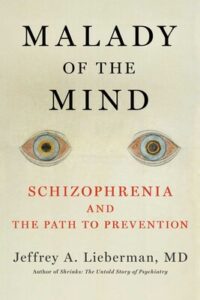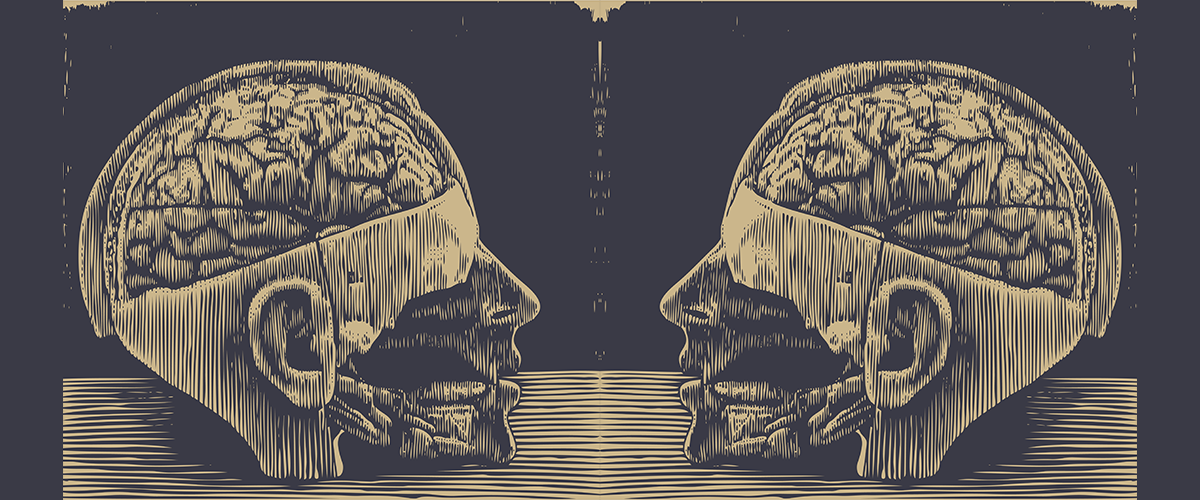The earliest form of psychosurgery, trepanation, the drilling of holes in the skull, had been practiced for hundreds of years. Paintings from the fifteenth and sixteenth centuries depict the practice, including Hieronymus Bosch’s The Extraction of the Stone of Madness and Pieter Huys’s A Surgeon Extracting the Stone of Folly.
The modern version of the procedure was pioneered by a Portuguese neurologist named António Egas Moniz. In 1935 Moniz attended a neurology conference in London, where he heard scientists from Yale describe how they had severed neural circuits in the frontal lobes of chimpanzees’ brains, a surgical procedure that had rendered the normally frenetic apes tranquil.
Moniz would say later that he had already been mulling over such methods by the time he saw the chimps; in any case, he returned to Lisbon ready to set in motion one of the most radical and troubling gambits in medicine’s efforts to treat mental illness.
With the help of a young neurosurgeon, Pedro Almeida Lima, Moniz performed his first leucotomy—more commonly known now as a frontal lobotomy—at the Hospital de Santa Marta in Lisbon on November 12, 1935. After the patient was placed under general anesthesia, Lima drilled two holes in the front of the skull, just above each eye; he then inserted the needle of a special syringe-shaped instrument—a leucotome—through the orbit, or eye socket, into the intracranial cavity. Pressing the plunger on the syringe, which extended a wire loop into the brain, Lima was able to rotate the leucotome, carving out a small sphere of brain tissue, the way one would core an apple. The procedure targeted the brain region directly behind the forehead that is the most highly evolved and uniquely human part of the brain.
In 1936 Moniz and Lima published the results of their first twenty leucotomies. Nine patients had been diagnosed with depression, seven had schizophrenia, two had anxiety disorders, and two were manic-depressive. Moniz claimed that seven patients improved significantly, another seven were somewhat improved, and the remaining six were unchanged.
The incessant din and commotion that had been so typical of mental institutions was replaced by a more agreeable hush.Moniz’s treatment was quickly celebrated as a miracle cure, spreading through the asylums of Europe and America. The reasons for its embrace are obvious if unforgivable. One of the biggest problems for asylum psychiatrists was the management of disruptive patients; short of physical restraints, there had been no way to control those who were persistently agitated, noisy, violent, and self-destructive. (In 1939 Moniz himself was shot by a patient, leaving him partly paralyzed.)
Now, after a relatively simple surgery, these patients could be rendered docile and obedient. The incessant din and commotion that had been so typical of mental institutions was replaced by a more agreeable hush. Patients who had smacked the walls, hurled their food or feces, and shouted at one another or at invisible specters now sat calmly and quietly. Moniz’s leucotomy seemed an answer to the psychiatrists’ prayers.
While most proponents of leucotomy were not oblivious to the dramatic changes in their subjects’ personalities, they argued that Moniz’s “cure” was more humane than putting people in straitjackets or padded cells for weeks on end; it was certainly preferable for hospital staff. The Nobel Prize committee recognized this and was convinced of its worth, and in 1949 Moniz was awarded the Nobel Prize for his discovery of “the therapeutic value of leucotomy in certain psychoses.”
Walter Freeman was the director of research laboratories at St. Elizabeths Hospital in Washington, DC, the federal mental hospital inspired by Dorothea Dix more than a century earlier. He was impressed by Moniz’s procedure and wanted to apply it to the abundant number of patients who had been at the facility for decades and for whom there were no prospects of effective treatment. Since Freeman wasn’t trained in neurosurgery, he enlisted the services of a neurosurgeon, James Watts, and in 1936 the two men carried out the first prefrontal lobotomy in the United States at George Washington University Hospital.
The inaugural patient was a woman in her sixties who’d had several nervous breakdowns and had been diagnosed as suffering from “agitated depression.” Prior to surgery, the woman had shown “uncontrollable apprehension, was unable to sleep, and by turns was laughing and weeping hysterically.” A few hours after the anesthetic had worn off, she was placid and reported feeling much better. In fact, she could not remember what she had been so afraid of. “I seem to have forgotten,” she said. “It doesn’t seem important now.”
Watts described the miraculous change in people who were suffering mental torments one minute, and the next, placid and free of distress.Freeman was excited by the initial results of his surgeries. Of their first 623 cases, he and Watts reported “good” outcomes in 52 percent of the operations, “fair” in 32 percent, and “poor” in 13, with 3 percent having died from the surgery. Not everyone was eager to embrace the new procedure, however. In 1937 Freeman proposed to William Alanson White, the superintendent of St. Elizabeths, that he lobotomize the hospital’s more difficult patients. According to Freeman, White replied: “It will be a hell of a long time before I let you operate on any of my patients.” After White’s death later that same year, Freeman and Watts performed lobotomies on fifty patients at St. Elizabeths.
Over time, Freeman and Watts made deeper and ostensibly more accurate incisions. They also replaced general anesthesia with an injection of novocaine. Because the brain is the only organ in the body that does not feel pain (and the novocaine took care of any pain that cutting through the scalp caused), patients were able to remain awake during the procedure, and Freeman and Watts could more easily monitor the effects of the cuts they were making to the brain. Watts described the miraculous change in people who were suffering mental torments one minute, and the next, placid and free of distress. It also meant that the patient could hear the drill as it bore into his or her skull and could feel the movement of the scalpel on the brain tissue.
*
Freeman and Watts’s most famous patient was Rosemary Kennedy, daughter of Rose and Joseph, and sister to President John F. Kennedy. Rosemary was born in Boston on September 13, 1918, the third of nine children. The birth was traumatic. While Rose had birthed her first two babies at home without complications, when she went into labor with Rosemary, a flu epidemic was raging in the city, and the doctor was not immediately available. The nurse on the scene had obstetrical training, but instead of delivering the baby herself, she delayed the birth by two hours, first by holding Rose’s legs together, then by holding the baby’s head and forcing it back into the birth canal, causing trauma and a damaging loss of oxygen.
Rosemary seemed like a physically healthy baby, but by the time she was a toddler, her parents were concerned about her behavioral development, and by kindergarten, it was obvious she was suffering from mental disability. The experts the family consulted pronounced Rosemary mildly intellectually disabled (the terms used at the time would have included “feebleminded” and “moron”). Her parents retained a team of tutors, who enabled her eventually to achieve a fourth-grade level in math and a fifth-grade level in English.
Along with the special educational arrangements, Rosemary’s activities and information about her condition were managed carefully. Her disability was kept a secret from everyone outside of the immediate family. But as she grew older, she became more difficult to control, so her parents placed her in convents where, thanks to her father’s largesse, they could be confident that she would be kept safe and out of the public eye.
In 1938, when Rosemary was nineteen years old, her father was named US ambassador to Great Britain, and she moved to London with her parents and siblings. In London, Rosemary thrived, briefly. She was apparently able to function socially, and was presented, along with her sister Kathleen, to King George VI and Queen Elizabeth at Buckingham Palace. Later, she went with her family to the investiture of Pope Pius XII in Rome. She did not live with her parents at the embassy in London but in a convent in Hertfordshire, northwest of the city, which trained Montessori schoolteachers and where she had a full-time companion to look after her.
When World War II broke out in the fall of 1939, her mother and siblings returned to New York. Her father remained for a time in London, and Rosemary stayed at Hertfordshire until May 1940. Her return to the States marked a significant worsening in her mental state. The mood swings the nuns had noticed when she was at Hertfordshire had given way to rages and violent tantrums. Doris Kearns Goodwin writes in The Fitzgeralds and the Kennedys, Rosemary paced “up and down the halls of her home . . . like a wild animal, given to screaming, cursing, and thrashing out at anyone who tried to thwart her will.”
At one point, she attacked her seventy-eight-year-old grandfather, hitting and kicking him until she was restrained. She shuttled from a summer camp in Massachusetts, to a Philadelphia boarding school, to a convent in Washington, DC, where things only grew worse. Rosemary took to sneaking out at night and wandering the streets. Such behavior posed the threat of illegitimate pregnancy, the sort of scandal that could derail her father’s political ambitions for his other children. As E. Fuller Torrey, schizophrenia researcher and advocate, has pointed out, Rosemary’s intellectual disability would have been a barrier to respectability, but to have a daughter who was seriously mentally ill or who became pregnant out of wedlock would be an unbearable disgrace.
By the time she died in 2005 at the age of eighty-six, members of her family had made disability and mental health central to their political platforms and advocacy work.Desperate for a solution, Joe Kennedy contacted Walter Freeman in the fall of 1941, and that November, at George Washington University Hospital, James Watts performed a prefrontal lobotomy on Rosemary, with Freeman supervising. Rosemary was mildly sedated but still awake. As Watts cut into Rosemary’s brain, Freeman spoke to her—asking Rosemary to recite the Lord’s Prayer or sing “God Bless America” or count backward. “We made an estimate on how far to cut based on how she responded,” Watts told Ronald Kessler, author of The Sins of the Father. When Rosemary started to become incoherent, they stopped cutting.
The lobotomy was a disaster, and left Rosemary an invalid; she regressed to the level of a two-year-old, was unable to wash or dress herself, and lost most of her speech. The family first sent her to a private psychiatric hospital before permanently relocating her, in 1948, to St. Coletta’s school and convent in rural Wisconsin, where they had a private house built for her and funded her full-time care.
According to David Nasaw’s biography of Joe Kennedy, The Patriarch, there is no evidence of anyone in the family visiting her for the first ten years or so that she was there. In 1961, Joe Kennedy suffered a stroke and was severely incapacitated for the last eight years of his life. In later years, after Joe’s death in 1969, Rosemary joined the family for reunions in Hyannis Port, Massachusetts. By the time she died in 2005 at the age of eighty-six, members of her family had made disability and mental health central to their political platforms and advocacy work.
As for Walter Freeman, his correspondence and private writings are, perhaps not surprisingly, “silent on the question of [Rosemary’s] surgery and its outcome.” What exactly did Rosemary suffer from? There had been the difficult birth. There had also been the flu epidemic; a wave of influenza swept through Boston when Rosemary’s mother, Rose, was in the third and fourth months of pregnancy, and we know now that maternal exposure to influenza at that point in a pregnancy is a possible risk factor for developmental disabilities, lower IQ, and schizophrenia.
In her autobiography, Rose Kennedy acknowledged that there were factors other than “retardation” affecting her daughter: “A neurological disturbance or disease of some sort seemingly had overtaken her, and it was becoming progressively worse.” It seems reasonably certain that Rosemary developed a psychotic disorder, which would not be entirely surprising: numerous studies have reported that between 4 percent and 8 percent of children with intellectual disabilities go on to develop schizophrenia or other psychoses, a figure significantly above the population average.
In 2015 Kate Clifford Larson published Rosemary: The Hidden Kennedy Daughter. Larson was the first biographer to have access to all of Rosemary’s known letters. In light of what Rosemary was ultimately subjected to, one line takes on an ominous air. In 1934, while a teenager away at boarding school, Rosemary wrote to her father: “I would do anything to make you so happy.”
*
Like the Kennedy siblings, playwright Tennessee Williams was haunted by what had happened to his own sister Rose, who had also undergone a lobotomy. Tennessee and Rose Williams were particularly close—“our love was, and is, the deepest in our lives,” he wrote in his memoir—and some of the most powerful moments in Williams’s plays arise from the dramatization of Rose’s fragility, notably the character Laura in The Glass Menagerie, who falls apart when her “gentleman caller” rejects her.
Rose, too, was abandoned by an “unscrupulously ambitious” boyfriend after her father created a scandal by losing his ear in a poker game. “Her heart broke, then, and it was after that that the mysterious stomach trouble began.” Echoes of Rose can also be seen in the wounded Blanche DuBois, who comes to visit her sister Stella in A Streetcar Named Desire and loses her sanity following her brother-in-law’s brutish assault.
Williams’s notebooks, published in 2007, show the playwright attempting to grapple with his range of emotions about his sister’s difficulties. “The house is wretched,” he writes in October 1936. “Rose is on one of her neurotic sprees—fancies herself an invalid—talks in a silly dying-off way—trails around the house in negligees.”
Williams’s notebooks, published in 2007, show the playwright attempting to grapple with his range of emotions about his sister’s difficulties.The following year, he describes the sensation of slowly losing someone to madness: “We have had no deaths in our family but slowly by degrees something was happening much uglier and more terrible than death.” By May of that year, Rose was in an institution and had been diagnosed with schizophrenia.
A medical report from 1939 recorded that Rose suffered from delusions of persecution, auditory hallucinations, and impaired memory. Her speech was “free and irrelevant.” She smiled and laughed while speaking of someone who was plotting to kill her. She masturbated frequently. Following a visit to his sister, Williams wrote of her continual laughter and obscenities, and of the doctor’s assessment of her hopeless condition: “We could only expect a progressive deterioration.”
In 1943 Rose’s parents permitted doctors to perform a lobotomy. “A cord breaking,” her brother wrote. “Rose. Her head cut open. A knife thrust in her brain. Me. Here. Smoking. My father, mean as a devil, snoring, 1,000 miles away.” The event found its way into Williams’s work, in Suddenly Last Summer, when an elderly socialite attempts to coerce doctors into lobotomizing her niece in order to prevent her from revealing that the woman’s son was homosexual.
Williams was haunted by the fear of what his sister’s infirmity might mean for his own mental health. As early as 1939, the playwright notes his fear that institutionalization will also be his fate. Williams was confined to a mental hospital in Saint Louis in 1969 for three months. A few years later, he said: “I’ve had a great deal of experience with madness; I have been locked up. My sister was institutionalized for most of her adult life. Both my sister and I need a lot of taking care of … I’m a lonely person, lonelier than most people. I have a touch of schizophrenia in me, and in order to avoid madness, I have to work.”
Williams’s dramatization of his sister’s travails might easily have veered into exploitation. Instead, as writer Colm Tóibín argues, the playwright managed in his best work to enable the shadow of madness that threatened him and took possession of his sister to “appear almost normal, an unsettled striving within the soul. He made its roots seem common to us all. But then, as he must have seen it develop in Rose, he dramatized its growth into a sort of poisonous power which slowly overcame and undid his characters.”
________________________________

Excerpted from Malady of the Mind by Jeffrey Lieberman. Copyright (c) 2023 by Jeffrey Lieberman. Reprinted by permission of Scribner, an imprint of Simon & Schuster, Inc.



